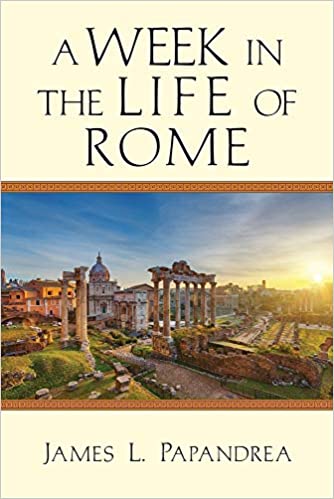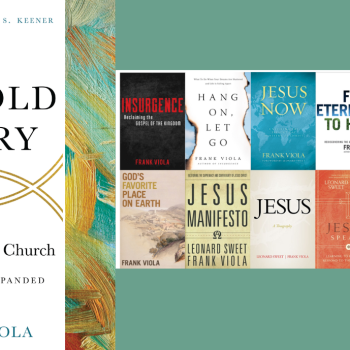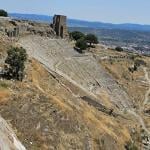James L. Papandrea has written a book entitled A Week in the Life of Rome (Downers Grove, IL: InterVarsity Press, 2019).
Recently, I caught up with James to discuss the book.
Enjoy!
How long did it take you to write this book?
Well, in one sense it took me my whole career, since I think everything I’ve ever studied has prepared me to write this book.
My PhD is in the history and theology of the early Church, as well as New Testament interpretation, and the history of the Roman Empire, so this book is really the combination of those three fields. But to answer the question more precisely, I think with the research and writing, I spent over a year on this book.
List 3 “aha” moments that shed light on the New Testament as you did your research.
I think the greatest “aha” moments for me were in connecting what we see in the text of the New Testament with the actual places in Rome.
So when I was figuring out where to place the house churches in the story, they each correspond to a real place where we know some of the earliest Christian worship took place – and these are places where I have been, places where I have prayed.
So now when I lead pilgrimages to Rome, I can show people who have read the book – this is where Stachys and Maria’s house was in the story. This is where Pudens’ house was in the story, etc.
Another “aha” moment was when I did the math and realized that Clement of Rome, the author of one of our earliest patristic documents outside of the New Testament, was actually still a slave while he was the bishop of Rome! That debunks a lot of misconceptions about the hierarchy of the Church.
So when I wrote A Week in the Life of Rome, which takes place in the year 50 AD, I made the future Pope Clement a young slave boy, tugging at the sleeves of the apostles.
And then I guess there’s the realization that people back then didn’t have forks or minutes.
I’ve read that the population of Rome in Paul’s day was around one million. I believe in your book you say it was 500,000. Why the discrepancy and what do you consider to be the best source for the population?
The truth is, we don’t really know for sure what the population was. There are historians who work on those things more specifically, and I surveyed their books, but even they are making their best guesses.
So the estimates range from less than half a million, up to one million. If I remember right, I made the decision to go with the lower end of the range because when I had done my research for my doctoral dissertation, I had come to the conclusion that the population of Rome was a million in the third century, and so I decided it must have been less in the first century.
I think it’s fair to assume the population of Rome increased from the first to the third century.
Share the context and setting of the book.
The story takes place in the year 50 AD, which is about seven years before Paul wrote his letter to the Romans.
We know that there was a house church meeting in the home of Priscilla and Aquila.
In Romans 16:3, Paul says that Priscilla and Aquila “risked their necks” for him. Giving it your best educated guess (as we can’t be sure), what do you think this COULD have referred to? How might have they risked their necks for him and when?
If I had to guess, maybe they protected him or hid him when someone was after him to try to arrest him or something.
It is an intriguing question. The interesting thing is that, for all we know about Paul, I found myself writing a story in which Paul doesn’t even enter the picture, because I was writing the story of the church at Rome, at a time before Paul had even been to Rome.
Also, can you share a few examples of why Seneca and Juvenal felt this way about the city? They said things like it was a cesspool of iniquity and a filthy sewer.
Juvenal was a kind of a moralist, so even though he was a pagan, he wants to hold people to a certain standard of ethics.
I think they are both philosophically-minded enough to believe that truly enlightened people do not necessarily just indulge their baser appetites, and I think this is what they saw happening in Rome.
Juvenal even criticized abortion – not because he thought abortion was morally wrong, but because he thought women who had abortions were too vain and too lazy to want to carry children, and he thought it was good for Rome to have more children, or at least sons.
Can you give us some examples of how your book sheds light on the New Testament story in the book of Acts?
The last time we see Peter in Acts (chapter 12), he has miraculously escaped from prison, and made his way to the house of Mary, the mother of Mark, where Rhoda is their servant.
What happened to Peter? How did Mark get to Rome? I answered these questions by speculating that Mary smuggled Peter out of Judea to Rome, bringing her son (who would later write the Gospel According to Mark) and her servant with her.
Also, there are a lot of cultural concepts that are mentioned in the New Testament as though the reader should know what they are or what they mean, but we live two thousand years removed from that world.
So this book bridges the gap by explaining things that allow the non-scholar to really understand what’s going on. Things like the way people counted time and the hours of the day, coins and money, Roman marriage, houses and apartments, Roman baths, pagan religion, what Roman meals were like, games and circuses, etc. All of this and more is explained in the book.
Finally, I use all the results of my research into the early Church to shed light on the state of Christian belief and practice in the first century. Readers will really see the first century Church, “from the inside” as it were.
What else would you like potential readers to know about your book?
On the one hand, I think that too many people read the New Testament as though all you need to study the New Testament is what’s in the New Testament.
That’s a grave error, because there is a lot of the context that you can’t really understand without also studying the Roman Empire, and the Early Church.
This book brings together all of that, to give a more complete picture of what’s behind the New Testament, and what kind of life the early Christians lived.
On the other hand, it can’t be emphasized enough that we find ourselves in a very similar situation to the early Christians, in that we live in a culture that is constantly forcing us to choose between Christ and Caesar.
I think the example of the early Christians is invaluable for anyone who wants to follow Christ today.











